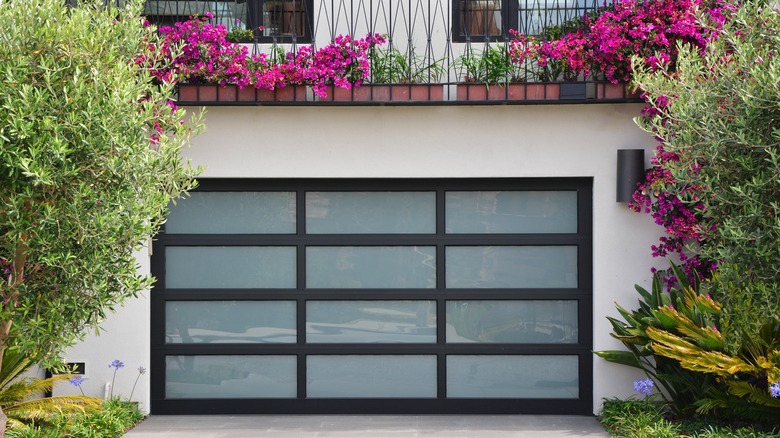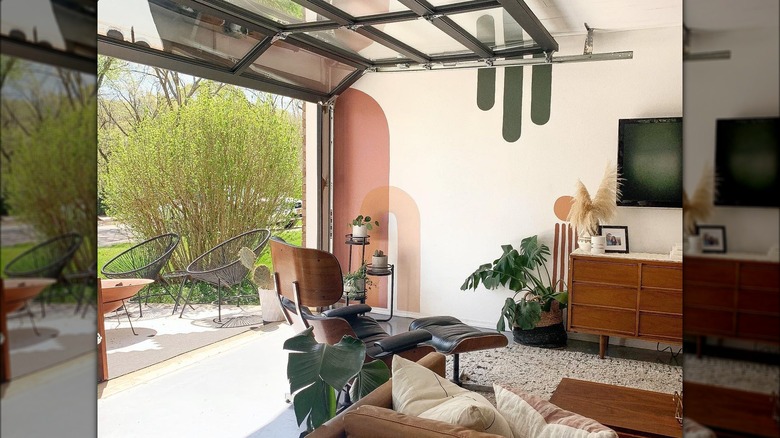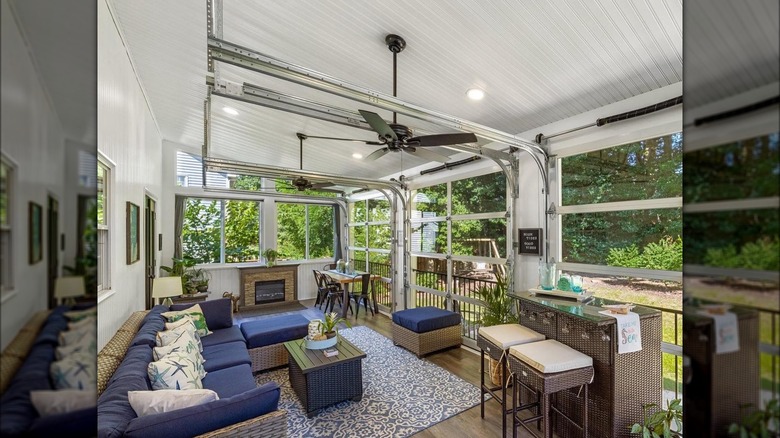Here's Why People Are Ditching Interior Doors For Garage Doors Inside Their Homes
Did you catch the epic sliding door upgrade Mina Starsiak Hawk showcased on HGTV's "Good Bones"? Replacing the traditional sliding door with a garage door in the living room was pure genius. But if you think she's the only one with this stellar idea, think again. Several homeowners are ditching their interior doors for garage doors inside their homes. Wondering why? Well, the primary reason is they add visual interest to the space and lend houses a distinct personality.
Plus, their glass panels let in natural light, helping you get your daily dose of Vitamin D without moving out of the comfort of your home. This is also great for your utility bills because you won't have to rely on artificial light mechanisms during the day. Moreover, if you love catching the sunset or starting your day by expressing your gratitude to the rising sun, you don't have to go beyond the comfort of your home. However, they come with their fair share of cons. Garage doors can be a safety concern if you have kids in the house and they try to wedge themselves between the door frame and the floor while the door is in motion. The associated springs and cables can be risky, too. That's not all. They're expensive to incorporate into a home's existing design. You'll also have to deal with dust and insects.
Reasons homeowners are using garage door indoors
As mentioned, garage doors make it easier to soak in the outdoors without leaving the comfort of our homes. Imagine catching the first snowfall of the season or marveling at a rainstorm without having to venture outside the interior doors. But this isn't the only reason. Garage doors double as room dividers sans the permanency and high costs. For instance, if you've got an open floor plan, you can use these doors to separate your living room, dining room, and kitchen from each other by bringing the doors down. Similarly, when you need the space, you can simply lift the doors overhead and mingle among these areas without issues.
Unlike walls, the doors don't take up a lot of space, but they do require ample room to swing outward or inward if you opt for a swinging door. Plus, the visual barriers aren't as steadfast, so they won't make the room appear smaller. Moreover, It'll be easier to traverse between rooms (or spaces). Considering installing a glass garage door but worried about privacy? Opt for tinted, frosted, or opaque glasses to get the best of both worlds. On the flip side, you'll have to insulate the garage doors to keep your utility bills to a minimum and enjoy a cool home in the summer and a warm one in the winters. Further, the clunky power buttons won't go with the rest of your interior decor unless you opt for a rustic design scheme.
How to use garage doors inside your home
There are multiple ways you can use garage doors inside your home. For starters, these doors can serve as the partition between your indoors and the great outdoors. Use them to separate your living room or kitchen from the backyard or patio. Think of all the parties you can host and the barbecues you can enjoy with your loved ones. It'd be akin to choosing an outside table at the restaurant when the weather is agreeable and moving indoors when the sun is oppressive or there are thunder clouds brewing in the distance.
Additionally, if you have an open floor plan, garage doors can serve as flexible wall dividers. Need a view to appreciate while you take your precious Peloton for a ride? Knock down the solid wall in your home gym and replace it with a garage door. The same logic applies to your home office, bedroom, and guest rooms. Alternatively, replace your old and worn front door with a sleek and modern garage door to improve your home's curb appeal. For fans of technology, smart and LED light-enabled garage doors are available, too. Just don't skimp on the quality and consider your needs to choose the right garage door for your interiors. For instance, if you don't have enough space to accommodate an up-and-over door, go with sliding, straight-up, or up-and-in options.


